News Brief
Bhojshala Survey Points To Paramara-Era Temple; ASI To Submit Report To Court On 2 July — Here's All You Need To Know
Kuldeep Negi
Jun 26, 2024, 09:41 AM | Updated 09:40 AM IST
Save & read from anywhere!
Bookmark stories for easy access on any device or the Swarajya app.


The Archaeological Survey of India (ASI) has reportedly completed a 96-day survey at Bhojshala in Dhar, with the excavation still in progress.
So far, more than 1700 artefacts have been uncovered, including numerous statues, structures, pillars, walls, and murals.
These findings are believed to date back to the Paramara period, which spans from the 9th to the 11th century.
Among the significant discoveries is a 27-feet long wall near a sanctum sanctorum, constructed with bricks instead of stone.
Archaeologists suggest that brick construction points to an even older era, possibly as ancient as the Mohenjodaro civilization, indicating that this site may be more ancient than initially thought.
Reportedly, inscriptions with Quranic verses and statues related to Jainism have been found near the left wall adjacent to the Kamal Maula Dargah.
The walls also feature murals depicting warriors preparing for, and engaging in battle.
The ASI is conducting this survey within a 50-meter radius of Bhojshala as per court orders.
With the survey nearing completion, a comprehensive report will be presented to the court on 2 July, with a hearing scheduled for 4 July.
According to archaeologists involved in the survey cited in a Dainik Bhaskar report, hundreds of artefacts have been found during the excavation, including statues of Hindu deities, pillars, murals, and inscription with Quranic verses.
They believe that based on the findings so far, the Bhojshala appears to be a Paramara period temple.
Detailed Findings from Specific Areas
Sanctum Sanctorum: A 27-feet deep excavation revealed part of a wall structure.
Room Underneath Stairs: 79 artefacts including statues of Vagdevi, Saraswati, Hanuman, Ganesh, along with conch shells and chakras.
North-Eastern Corner and Dargah's Western Part: Statues of Krishna, Vasuki Naga, and Shiva.
North-Southern Corner: Pillars, swords, and 150 carved remnants of walls.
Yagyashala Area: Stones with Sanatani symbols.
Dargah: Identification of an underground Akal Kuiyan.
Chemical Treatment on Pillars: Revealed carvings of Sita-Ram and "Om Namah Shivaya" inscriptions.
Kuldeep is Senior Editor (Newsroom) at Swarajya. He tweets at @kaydnegi.





